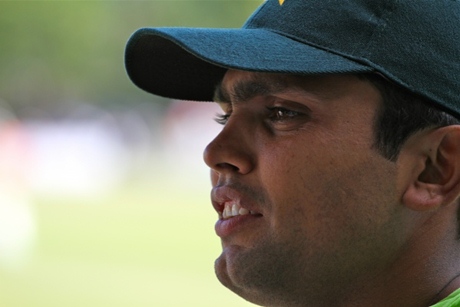We don’t write about wicketkeepers very much and that’s wrong. Batsmen and bowlers aren’t the only ones deserving of our attention. Squatters have rights too. This article is about the select band of stumpers who have averaged more than two dismissals an innings in Tests.
Wicketkeepers who’ve taken two dismissals an innings and over. It’s not many, you know. If we limit ourselves to guys who’ve played at least 20 Tests so that we can rule out Steve Rhodes, we’re left with just six men and also Brad Haddin.
(Somewhat surprisingly, Rishabh Pant tops the list if we relax the qualification to 10 Tests. Pant averages 2.346 dismissals per innings. This is maybe just a reflection of the fact that teams are being bowled out more often at the minute.)
So who was the busiest?
Let’s rank them in reverse order. (A small amount of weight has also been given to matches played, but we’re not saying how much because you’ll only find fault with how we’ve chosen to do this. This website is not about transparency; it is about unnecessarily laying into Brad Haddin.)
Courtney Browne, West Indies – 20 Tests and 2.250 dismissals per innings
Courtney Browne is a cricketer who crops up in almost no lists for anything. If David Dunn is the antithesis of brittle-boned Mr Glass, Browne is the man who balances out Vinoo Mankad – who crops up so regularly he’s now even managed to get a mention in an article about wicketkeepers.
Three facts about Courtney Browne:
- He was born in Lambeth in London
- He won the 2004 Champions Trophy for the West Indies, making 35 not out in the final batting at nine, but nobody really remembers
- He made his Test debut because Junior Murray had the wild shits the night before. Richie Richardson said Murray’s decision was “a bit disappointing” which tells us that Richardson has never once suffered the wild shits
Pretty much the first thing Browne did as a Test cricketer was drop Steve Waugh on 42.
Waugh made 200.
During his career, Browne mostly kept wicket to Curtly Ambrose, Courtney Walsh and Ian Bishop. This explains why he took catches so often.
He also took all of two stumpings: one off Jimmy Adams and one off Chris Gayle.
Geraint Jones, England – 34 Tests and 2.015 dismissals per innings

Underlining the fact that it pays to keep wicket to good bowlers, Geraint Jones timed his career to precisely coincide with a bunch of quicks who we don’t even need to name and also Liam Plunkett.
Jones was born in Papua New Guinea, so he and Browne encourage the theory that you need to have been born in a different country than the one you play international cricket for to be involved in more than two dismissals per Test innings.
This is not a very catchily-worded theory, so hopefully it will be swiftly disproven.
As well as 128 catches – including one biggie that should really count for at least 100 on its own – Jones took five stumpings: two off Monty Panesar and three off Ashley Giles.
The Giles ones included two in one innings. They were an elite pair: Tino Best and Pedro Collins.
Collins had made two runs in an hour.
It was a great Test match. Rob Key made 221 in it.
Brad Haddin, Australia – 66 Tests and 2.109 dismissals per innings
Brad Haddin was born in Australia so there’s an end to the ‘born in a different country’ theory and there’s yet another thing that Brad Haddin has ruined.
We weren’t quite sure whether to have Braddin (Braddin? What the hell? How did we only write that for the first time by accident?) or Quinton de Kock next in our list. Then we remembered that in any situation where you can diminish Haddin’s achievements, you should always do so.
Haddin took 262 catches and we don’t care enough about him to check who they were off. He managed only eight stumpings in all those Tests as well, which is, quite frankly, feeble – just like Brad Haddin himself.
Quinton de Kock, South Africa – 47 Tests and 2.321 dismissals per innings
The way that we see it, Quinton de Kock has got three things right.
- He didn’t play any Tests in the flat pitch era
- He’s kept wicket to Dale Steyn, Vernon Philander, Morne Morkel and Kagiso Rabada
- He’s kept wicket on the kinds of home pitches you’d definitely want to play on if you had access to the bowlers listed above
As well as 191 catches, De Kock has also taken 11 stumpings. These were mostly off Keshav Maharaj, but also off JP Duminy, Stiaan van Zyl and Tabraiz Shamsi.
Adam Gilchrist, Australia – 96 Tests and 2.178 dismissals per innings
If you look at all of the wicketkeepers – all of them – then Adam Gilchrist is the best batsman.
That’s what Gilchrist known for. Even if you set aside all of the hundreds and World Cup wins, he is probably one of the finest purveyors of the off-larrup there’s ever been. He could be remembered for that alone.

Larrup.
But Gilchrist was also quite a busy keeper. He kept to Shane Warne, after all. His 37 stumpings piss all over these other guys’ efforts from a very great height.
What sort of height? Using the correct units of measurement for height, Adam Gilchrist’s number of stumpings piss all over everyone else’s numbers of stumpings from a height of one Eiffel Tower and six double-decker buses.
Tim Paine, Australia – 31 Tests and 2.333 dismissals per innings
Tim Paine has the greatest number of dismissals per innings of wicketkeepers who meet our 20-Test qualification criterion.
This is somewhat disappointing.
It’s surprising too – but mostly it’s disappointing.
Mitchell Starc, Pat Cummins, Josh Hazlewood and Nathan Lyon comprise a handy attack and most of Paine’s busiest keeping days have come when all four have been in the team.
11 times he’s netted four or five victims in an innings and on six of those occasions, all four of those bowlers have been playing. Considering Australia fairly regularly throw in a James Pattinson or a Peter Siddle, that’s really rather striking.
Tim Paine isn’t Test cricket’s busiest wicketkeeper though.
Kamran Akmal, Pakistan – 53 Tests and 2.080 dismissals per innings

First things first: what the holy ballbags? Kamran Akmal has snuck into an elite wicketkeeper bracket? Have we gone number-blind or number-dumb or something?
Second things second: you’re waiting for an explanation of how Kamran Akmal is a busier wicketkeeper than all the guys above.
That’s easy.
Kamran Akmal is not what you’d call a safe pair of hands. There are times when it actually seems like he is not the owner of hands at all.
When he dropped Ross Taylor twice on the way to a hundred in 2011, we wondered whether he actually had footballs made of ice on the ends of his arms. It seemed to make more sense.
Then there was that time he was only prevented from dropping Mike Hussey a fourth, fifth and sixth time by Australia drawing proceedings to a close by winning the game.
We have to factor this in.
Imagine that Kamran Akmal secures two dismissals in an innings. Now imagine how many chances he must have been presented with for those two dismissals to have ensued.
It’s a lot, isn’t it?
If Kamran Akmal secured on average two dismissals an innings for his entire 53-Test career, one can only conclude that he must have been by far the busiest wicketkeeper in Test history.
We can only write features like this because of all the people who are kindly funding King Cricket on Patreon. If you like what we’re doing and you’d like to see us to do more of it, please feel free to chip in a very small amount. You can flip us a shiny coin or buy us a pint each month here.



Worth it for the ‘squatters’ rights’ joke in the intro alone
How time flies. I didn’t realise that Gilchrist played in black and white.
Sentences like “ This website is not about transparency; it is about unnecessarily laying into Brad Haddin.” are the reason we keep coming back here.
(Somewhat surprisingly, Rishabh Pant tops the list if we relax the qualification to 10 Tests. Pant averages 2.346 dismissals per innings. This is maybe just a reflection of the fact that teams are being bowled out more often at the minute.)
I think this is more on India’s bowling attack. Their best seam bowlers over the last few years (Bumrah and Sharma) are length seamers who get a lot of wickets bowled and caught behind, and generally don’t make use of a full slip cordon like, say, Anderson and Broad do. Their only convential outswing bowler is probably Bhuveneshwar Kumar who hasn’t gotten as many games since Dhoni retired.
Yes, the theme is definitely – and not really surprisingly – that you need to keep to an effective bowling attack.
Also explains the preponderance of Aussie keepers—”tall seamer who consistently hits a good length” describes practically every Australian fast bowler of the last 20 years, whereas the likes of Matt Prior and BJ Watling, who keep/kept to bowlers much more reliant on swing, are conspicuously absent.
I’m trying to work out where the black and white Gilchrist picture is from. I’m just trying to envisage thats mall stand and can’t quite visualise it anywhere. Trent Bridge? One of those old small stands I vaguely remember from there? 2005?
Australia possibly.
No corked hats to be seen in the crowd – but a sombrero – surely not possible.
There are a pair of Australian flag shorts in the crowd. Not sure if that helps locating it.
It’s definitely Australia—the Channel Nine logo in the top right is a dead giveaway. My guess is it’s Adelaide, but it could also be the WACA. Only thing I’m sure of is it’s not the MCG.
Well spotted, Dan M.
Absence of corked hats disappointing, still.
I remember that name very well. Courtney Browne
There are somethings you don’t forget. For ex. Shaukat Dhukanwalla producing MoM performance in UAE vs NED in 1996 ODI world cup
(This also shows that I must find a productive vocation for myself)
‘the last dance’
Picture the scene. Your opponents are 300 for 2. Your captain has, quite reasonably, positioned his most attacking fielder at extra cover. Everyone else is on the boundary. Your main strike bowler has the accuracy of a garden sprinkler, not an accidental simile.
You are covering everything between second slip and leg slip, and the disguise on direction is so great that not even the bowler knows where it’s going. You take half a step to your right, only to see the ball fired a foot down leg side, pummelling into the boards and into the “Byes” column against your name. You know its not your fault, but you also know that in twenty years the statistics will be the only thing people judge you by.
These are the busiest times for a keeper. The only time you are not involved to the limits of your ability are when the bowler puts one in reach of the batsman, when it becomes deep backward point’s job to pick up the ball.
The busiest keeper must be Brad Haddin.
I did some digging and believe I can lessen your disappointment somewhat. Even though de Kock has played 47 Tests thus far, he has been a wicketkeeper in only 45 of these. It would be unfair to count the matches in which he was not even asked to do the job. His dismissals per inning as designated wicketkeeper is 2.404 easily knocking Timmy from the top.